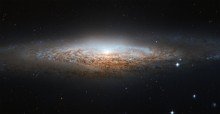Apologies for the hiatus, but moving house, Xmas preparations (and the aftermath), have meant an almost complete lack of stargazing. Now, though, with the decks (mostly) cleared, I’m starting to think about what there is to look forward to in the early part of 2017.
Leo
Nicely positioned in the east at around 10PM from the end of January, Leo heralds the start of ‘galaxy season’. I’m looking forward to reacquainting myself with a couple of galaxy clusters in Leo: the M65 and M95 clusters. Both contain three galaxies, in close visual proximity, and make for a fascinating sight in even moderate scopes.
There are lots of galaxies on view in Leo, some harder to spot with amateur equipment than others. One could easily spend a whole evening exploring the constellation. One of the easier galaxies lies just off the front of the constellation, and should be visible with magnifications of x20 and up. NGC 2903 is a very bright barred spiral galaxy, about 30 million light years away, and is well worth a look.
Hot on the heels of Leo are the constellations of Virgo and Coma Berenices, and the incredible Virgo galaxy super cluster. Although several can be spotted with binoculars, a moderate scope (a 5in reflector, for example) will reveal dozens of individual galaxies. Quite the experience!
The return of Jupiter
Although currently very obvious in the pre-dawn sky (high in the southwest), we’ll have to wait for a while before Jupiter will be visible in the evenings. It seems like ages since I’ve seen the gas giant through my scope, and my excitement levels are rising as the days go by. By around the middle of February Jupiter will be clearing the eastern horizon, in the constellation of Virgo, from around 11PM.
NGC 2683
Bit specific this one, I mention it here only because it’s been on my hit list for a while now, and is ideally placed for viewing. A magnitude 9.7 spiral galaxy in the constellation of Lynx. Viewed nearly edge on, it’s also known as the UFO galaxy.
Canes Venatici
Although one of the least obvious constellations, it does ‘contain’ a wealth of astronomical objects. With the Big Dipper up on its handle at the moment, Canes Venatici is just to the right of the lower stars in the ‘handle’. There’s the Whirlpool galaxy (M51), the Sunflower galaxy (M63), the Whale galaxy (C32), M94, M106, the Cocoon galaxy, plus C21 and C26 … There’s also the stunning M3, a globular star cluster at the lower end of the constellation. One of the largest and brightest globulars in the northern sky, it’s made up of around 500,000 stars!
Open clusters
To the left of Orion (currently due south) lie the constellations of Monoceros, and, below that, Canis Major. There are literally dozens of open clusters in this part of the sky.
What’s up?
The next New Moon will be on the 28th of January, with February’s Full Moon appearing on the 11th. As for planets, Mars, Venus and Uranus are all visible in the evening sky, though you’ll need binoculars to see the latter. Jupiter, as I mentioned above, is the brightest object in the pre-dawn sky.
For those with ambition, the asteroid Vesta can be seen (with binoculars) between Cancer and Gemini in the evenings.
Below and to the left of Orion is the constellation of Canis Major, with the incredibly bright star Sirius. Over to the left of Sirius are the open clusters M47 and 46, the latter a particularly fascinating sight, and one of my favourites. As well as the sparkling star cluster, there’s a small planetary nebula in the foreground. You’ll need a telescope to see the nebula, but it’s highly recommended.
To the right of Sirius is the constellation of Lepus, and Hind’s Crimson Star. According to the star’s discoverer, Hind, it appeared ” … like a drop of blood on a black field.”
This is a good time of year to view the Andromeda galaxy. Recently it’s been very high overhead, and a bit of a strain on the neck to see. Now lower, in the west, it’s perfectly placed. I actually had a look a couple of nights ago, and, even though it’s a familiar sight, it was spectacular!
If you’re interested in astronomy/stargazing, or would just fancy having a look through a fairly large telescope, do consider coming along to The New Inn in Cerne Abbas for my monthly stargazing sessions. The next one (weather permitting) is on Sunday the 29th of January, from 6PM.
Clear skies!
Kevin Quinn is an amateur astronomer based in Piddletrenthide. He is the proud owner of a ten-inch reflector, a small refractor, a case of eyepieces, and a couple of pairs of binoculars. He tweets via @CerneAstro, and blogs (occasionally) via theastroguy.wordpress.com.
©Kevin Quinn












